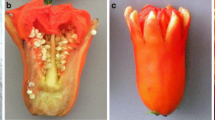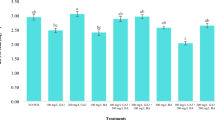Abstract
The effect of 17-dimethylmorpholinium chloride (17-DMC), a quaternary ammonium salt, on stem growth and productivity of spring rape (Brassica napus L., cv. Star), and on phytohormone content in stem tissues was studied. We found that the effects of 17-DMC on stem growth (inhibition of linear growth, development of anatomical structure and mechanical properties) were manifested as the changes in stem hormonal balance, particularly, in a decrease in the contents of GA, zeatin, and IAA and an increase in the ABA content. Seed weight increased due to the retarding effect of 17-DMC on stem growth and the promotion of silique and seed development.
Similar content being viewed by others
REFERENCES
Prusakova, L.D. and Chizhova, S.I., Synthetic Regulators of Plant Development, Natural and Synthetic Regulators of Plant Ontogeny, Itogi Nauki i Tekhn., Ser. Fiziol. Rast., 1990, vol. 7, pp. 84–124.
Fletcher, R.A., Hofstra, G., and Gao, J.G., Comparative Fungitoxic and Plant Growth Regulating Properties of Triazole Derivatives, Plant Cell Physiol., 1986, vol. 27, pp. 367–371.
Rademacher, W. and Evans, J.R., Pix and Other PGRs for Crop Plants, Proceedings of the Plant Growth Regulation Society of America, Twenty-Third Annual Meeting, Calgary (Canada): Univ. Calgary, 1996, pp. 236–241.
Zhou, W. and Ye, Q., Physiological and Yield Effect of Uniconazole on Winter Rape (Brassica napus L.), J. Plant Growth Regul., 1996, vol. 5, pp. 69–73.
Prusakova, L.D. and Chizhova, S.I., Application of Triazole Derivatives in Plant Growing, Agrokhimiya, 1998, no. 10, pp. 37–48.
Miliuvien?, L., The Possibility of Using the Quaternary Ammonium Salts in Technology of Rape Growing, Fiziol. Biokhim. Kul't. Rast., 2000, vol. 32, pp. 288–296.
Veselov, D.S., Sabirzhanova, I., Akhiyarova, G., Veselova, S.V., Farkhutdinov, R.G., Mustafina, A.R., Mitrichenko, A.N., Dedov, A.V., Veselov, S.Yu., and Kudoyarova, G.R., The Role of Hormones in Fast Growth Responses of Wheat Plants to Osmotic and Cold Shocks, Fiziol. Rast. (Moscow), 2002, vol. 49, pp. 572–576 (Russ. J. Plant Physiol., Engl. Transl.).
Merkys, A.I., Darginavichien?, Yu.V., and Novickien?, L.L., Specificity of CCC Action on the Growth of Wheat and Barley, Fiziol. Biokhim. Kul't. Rast., 1974, vol. 6, pp. 358–364.
Merkys, A.I. and Miliuvien, L.I., The Effect of Chloride-Trimethyl-?-Chlorethylammonium on the Illumination Dependence of the Intercalary Growth of Grass Shoots, Fiziol. Biokhim. Kul't. Rast., 1975, vol. 7, pp. 131–137.
Skorobogatova, I.V., Zakharova, E.V., Karsunkina, N.P., Kurapov, P.B., Sorkina, G.L., and Kislin, E.N., Changes in Phytohormone Content in the Barley Seedlings of Different Ages after Application of Growth Stimulators, Agrokhimiya, 1999, no. 9, pp. 57–59.
Zhou, W. and Leul, M., Uniconazole-Induced Tolerance of Rape Plants to Heat Stress in Relation to Changes in Hormonal Levels, Enzyme Activities and Lipid Peroxidation, Plant Growth Regul., 1999, vol. 27, pp. 99–104.
Prozina, M.N., Botanicheskaya mikrotekhnika (Botanical Microtechniques), Moscow: Vysshaya Shkola, 1960.
Skorobogatova, I.V., Zakharova, E.V., Karsunkina, N.P., Kurapov, P.B., Sorkina, G.L., and Kislin, E.N., Changes in Phytohormone Content in the Barley Seedlings during Development under Application of Growth Stimulators, Agrokhimiya, 1999, no. 8, pp. 49–53.
Songailien?, A. and Ženauskas, K., Tyrimo duomen? biometrinis ?vertinimas, Vilnius: Mokslas, 1985.
Thurling, N. and Vijandradas, L.D., The Relationship between Pre-Anthesis Development and Seed Yield of Spring Rape (Brassica napus L.), Aust. J. Agric. Res., 1979, vol. 31, pp. 25–36.
Diepenbrock, W. and Grosse, F., Rapeseed (Brassica napus L.). Advances in Plant Breeding, Physiological Potentials for Yield Improvement of Annual Oil an Protein Crops, Diepenbrock, W. and Becker, H., Eds., Berlin: Blackwell, 1995, pp. 21–89.
Bouille, P., Solta, B., Miginiac, E., and Merrien, A., Hormones and Pod Development in Oilseed Rape (Brassica napus), Plant Physiol., 1989, vol. 90, pp. 876–880.
Guilfoyle, T.J. and Hagen, G., Auxin Response Factors, J. Plant Growth Regul., 2001, vol. 20, pp. 281–291.
Leyser, O. and Berleth, T., Auxin Signalling: The Beginning, the Middle and the End, Curr. Opin. Plant Physiol., 2001, vol. 4, pp. 382–386.
Ohtake, Y., Takahashi, T., and Komeda, Y., Salicylic Acid Induces the Expression of a Number of Receptor-Like Kinase Genes in Arabidopsis thaliana, Plant Cell Physiol., 2000, vol. 41, no. 9, pp. 1038–1044.
Novickien?, L. and Darginavichien, Yu., Morphological Processes at the Rooting of Green Cherry Tree Cuttings, Sodininkyst ir dažininkyst?. Mokslo darbai., 2001, vol. 20, no. 3, pp. 160–175.
Author information
Authors and Affiliations
Rights and permissions
About this article
Cite this article
Miliuvien, L., Novickien, L. & Gavelien, V. Effect of 17-DMC on Phytohormone Level and Growth of Rapeseed Plants (Brassica napus). Russian Journal of Plant Physiology 50, 656–660 (2003). https://doi.org/10.1023/A:1025644308841
Issue Date:
DOI: https://doi.org/10.1023/A:1025644308841




